Arnon Z. Shorr's Blog, page 2
November 13, 2022
Ritual Objects and Lost Traditions - Themes of Loss and (Re)Discovery
I've heard over the years that it's very important to understand your own creative voice as a writer. You need to know who you are, what you stand for, what stories you're compelled to tell (or, really, what story you find yourself re-telling over and over). For a long time, I didn't really know what drove my stories. To some degree, I'm still discovering new themes and layers of narrative that compel me to write. And as I grow, the themes and ideas that animate me evolve as well - as they must!
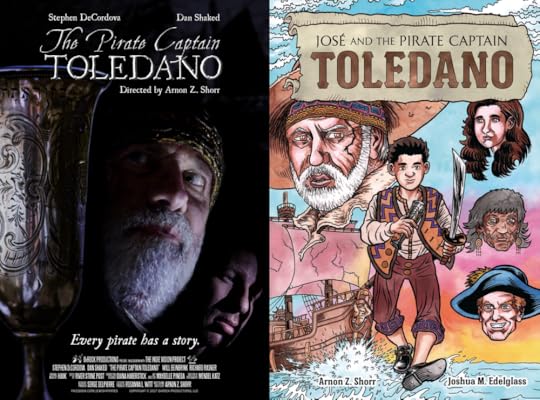
When I first made "The Pirate Captain Toledano", and then when I revisited the story for the graphic novel, "José and the Pirate Captain Toledano", I found myself tapping into a part of me that hadn't appeared in many of my previous stories. The film revolves around a 16th century Jewish refugee from the Spanish Inquisition who stows away on a pirate ship. He brings with him a silver kiddush cup - a Jewish ritual object that had belonged to his father.
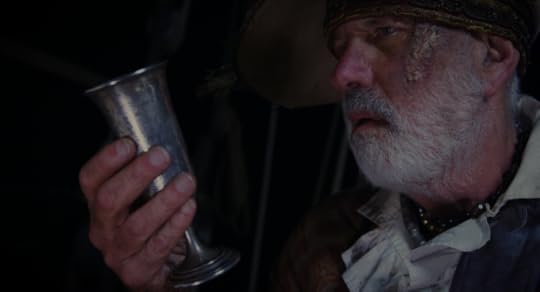
In the book, which expands on this story, the stowaway is a young teenager who only recently discovered his secret Jewish identity. He has the ritual object, but doesn't know the ritual.
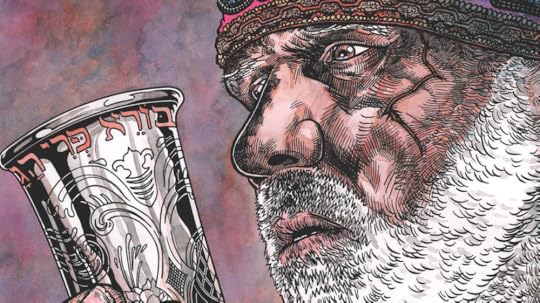
As I've discussed elsewhere, the cup in this story was inspired by a silver kiddush cup that was given to me by my grandfather at my wedding. It had belonged to his grandfather, Rav Yaacov Schorr of Kuty (or Kitow) in what is now Western Ukraine.

The cup was a ritual object that had been passed down through four generations, three continents, an entire century. But there was something missing in that inheritance. Although my grandfather's grandfather was a notable Rabbinic scholar and sage, my grandfather rejected the trappings of traditional Judaism when he was a teenager. By the time the cup reached me, the family traditions were mostly lost to history.
There were some traditions that my grandfather held on to in some way. The Passover Seder was always an important affair, even if my grandfather would revel in questioning the veracity of the Biblical exodus, and even if no one even remembered that the original owner of the silver kiddush cup also wrote a commentary on the Hagadda.
And Chanukah was always treated as a notable event.
For weeks before Chanukah, my grandparents would pull out their various chanukiyot - the eight-branched candelabras that hold the Festival's lights. They'd brush off the dust, clean off old wax, polish them, and display them on a tastefully-crowded tea cart in the living room. Chanukah was particularly special in my grandparents' house. It was a tradition they kept.
Although "José and the Pirate Captain Toledano" offers a subtle rebuke of my grandfather - and perhaps a bit of wish-fulfillment in the way the Captain takes on the role of religious educator for the young stowaway - I suppose I felt a subtle need to acknowledge what my grandparents did pass down to me. The story itself is a sort of liberation narrative, where the sea (split, perhaps, by the prow of a ship?) is the place to go to become free from oppression. And when José is told about his Jewish heritage, he is shown a box of ritual objects that his father had hidden - including a chanukiyah. For this image, I sent a photo to Josh Edelglass, the book's illustrator. It was a photo of a chanukiyah that my grandparents had given me - one of their own, from their collection, which I remembered from that tea cart in their living room.

I don't know when they got this chanukiyah, or what part of the world it's from, but it's an object they used for a tradition that they did transmit to me. It felt important to somehow include it in the book.
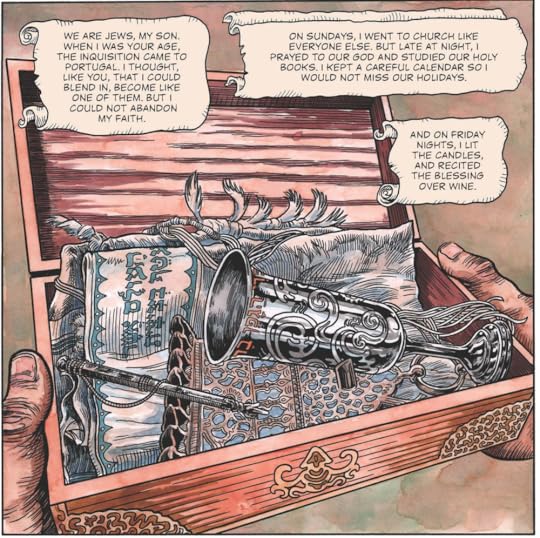 https://youtu.be/w9W9jaC-AXw
https://youtu.be/w9W9jaC-AXwIt felt very cathartic, in a way, to process my own broken connections to a religious heritage through the "Toledano" projects, but it seems I'm not through with that thematic angle. My next series of comics - coming soon from a new Jewish imprint at Source Point Press - revolves around an archaeologist who discovers that he's Jewish just as he's about to embark on a globe-trotting adventure in search of the lost magical treasures of King Solomon. "Ben Mortara and the Thieves of the Golden Table" is yet another story of a seeker, cut off from his heritage, searching for the things that might lead to a better understanding of who he is or where he comes from.
Unlike Ben Mortara, and unlike José, I've never had any doubt as to my Jewish identity, even if the links to tradition have been weak. As we approach another Chanukah, and as I pull out my grandparents' chanukiyah to dust it off and polish it and set it on the tea cart (yes, that eventually made it into my living room, too), I'm reflecting with gratitude on my grandparents, who, even despite their skeptical view of religion, managed to hold onto enough of it to give me a thread to grasp. A thread that ties me - tenuously - to that ancient chain.
~~~~~~~
There's a whole other kiddush cup story associated with Toledano. Check out the video about it, here:
https://youtu.be/7CWwDoxeWJA"The Pirate Captain Toledano" is available on Amazon: https://amzn.to/3XcaJcH To buy the book, you can get it directly from Kar-Ben Publishing at https://www.karben.com/Jos%C3%A9-and-the-Pirate-Captain-Toledano_p_1163.html
Or you can find it Amazon as well: https://amzn.to/3g64ZQY
I'll post links about Ben Mortara and some upcoming titles from Source Point Press as soon as there are links available.
Have a wonderful Chanukah!
-Arnon
September 11, 2022
For the Sammy Fabelmans of the World
I was inspired by the just-released trailer for Spielberg's #TheFabelmans to share some of my own childhood footage.
https://www.youtube.com/watch?v=D1G2iLSzOe8The trailer includes shots of the fictional Sammy Fabelman filming a model train set.
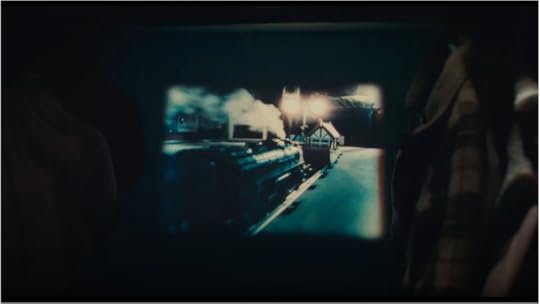
It's a tale from Spielberg's own childhood in the 1950s - and something I did, too, as a film-crazed kid in the 1990s.
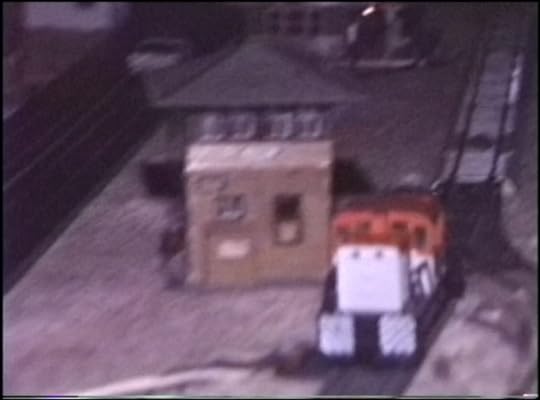
The Sammy Fabelmans of the world are passionate creators - but they rarely get to see that the folks who've 'made it' also started out like them - with only our dreams, making dumb things with bad tools in weird places.
I remember when I was 'Sammy Fabelman'. These experiments with old train sets on the floor of my bedroom were lonely affairs. No one else participated. No one watched the footage. No one gave me advice, or guidance, or support. I knew there was magic to be captured, but I also knew I hadn't captured it. There's disappointment in those early experiments.
There's joy, too - the joy of catching that glimpse of something. At one point, I put the camera's lens right up to the doorway of a "factory" that the train would zip through. Through the lens, I could see a different world - a special place that was bigger than the universe, but could somehow fit on my bedroom floor. No one else got to see that magic - because I hadn't captured it well. The shots are blurry, shaky, poorly lit, and they don't tell a story. But I caught a glimpse of how cinema can lift us out of ourselves and transport us to better places.
That strange combination of exhilaration and loneliness - of discovery and the inability to share it - that marks the "Sammy Fabelman" experience. There are Sammy Fabelmans out there now, playing with phone cameras, editing on laptops, trying to make sense of this magic they can sense but can't yet fully express... It's maddening, but it doesn't have to be so lonely anymore. We can show them that where they are - their flawed attempts to make magic - that's where we started, too.
https://www.youtube.com/watch?v=q3tSusDUmIQSo I share some of my first baby-steps into filmmaking, and I encourage fellow filmmakers to share theirs. Let's see how you got your start! What are your earliest experiments with movie magic?
Share them. Tag them. So the Sammy Fabelmans of the world know we were all beginners once.
#IAmSammyFabelmanToo #filmmaking #filmmaker #spielberg #inspiration #creative
February 14, 2022
Reflections on an Amazon Category: "Children's Prejudice and Racism Books"
I don't know who chooses what category to put a book in when it's listed on Amazon, but my upcoming graphic novel, "José and the Pirate Captain Toledano" happens to be included in the category "Children's Prejudice and Racism Books".
As pre-orders for my book are increasing, it's rising in the Amazon rankings. Yesterday, the paperback got close to cracking the top-100 in the "Children's Prejudice and Racism Books" category. So I got curious. What other books are in this category? Who am I sharing this space with?
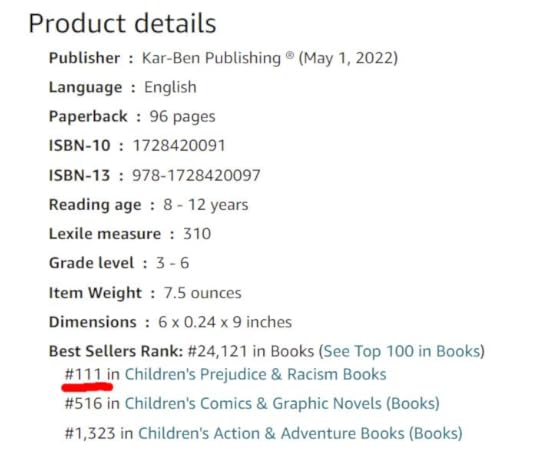
February is Black History Month, and the echoes of the Black Lives Matter protests continue to resonate loudly, so it's not surprising that the vast majority of books in the top-100 of this category explore matters of American Black/White racism. Some explore historical events or tell the stories of famous people. Others are works of pure fiction that try to frame racism in a way that kids can grasp and grapple with productively.
But I was curious to see how many of these books explore anti-Semitism directly. How are we represented in this topic of "prejudice and racism" at the top of Amazon's kidlit charts?
Here are the books I found, and their rankings (as of 2/14/22 at 8:45am)
#30 "What was the Holocaust?" by Gail Herman - part of a popular kids' history series.
#36 "Linked" by Gordon Korman - A fictional tale about a bunch of kids in a small school that reels from the discovery of swastika graffiti.
#75 "Nicky & Vera: A Quiet Hero of the Holocaust and the Children He Rescued" by Peter Sís - about Nicholas Winton
#100 "Don't Tell the Nazis" by Marsha Forchuk Skrypuch - about a non-Jewish Ukrainian kid who's faced with the challenge of protecting her Jewish friends from the Nazis.
Jews don't make up a huge part of the American population, so I wasn't expecting to find too many Jewish-themed books. Also, this category is explicitly about "prejudice and racism", so books that depict Jews who aren't struggling with some sort of oppression wouldn't show up here.
But here's where I'm surprised and somewhat disappointed.
None of these books has a Jewish protagonist.
Let that sink in.
Of the 100 most popular books that address prejudice and racism in a kid-appropriate way, the only books that explicitly explore prejudice against Jews are one history of the Holocaust, and three books about people who aren't Jewish. And those three books are also directly or indirectly Holocaust-related (two Holocaust stories, and one contemporary tale about a swastika - which is an image that became associated with anti-Semitism only in conjunction with the Holocaust).
Don't get me wrong: I'm glad there's a kids' history book about the Holocaust, and that it's popular. It's an important piece of history. I'm also glad there are stories about "righteous gentiles". Kids need heroes to model, and (like we've heard from various minority groups before) kids need (some) heroes that look or sound like them.
But so much of what this literature is meant to do is introduce us to those people who aren't like us, so we can see their humanity and celebrate it! We want our kids to read stories about kids with darker (or lighter, or just different) skin, or kids with differently-shaped eyes, or kids who speak other languages or who have different religious rituals or cultural celebrations. We want them to see that common humanity, right? We want to show that difference is the one thing we have in common! So where are the stories that introduce Jews-as-whole-characters to these readers? Why aren't there any of those in the top-100?
Also, this persistently myopic, two-dimensional portrayal of anti-Semitism and its discontents leaves so much out of the conversation.
First, it portrays anti-Semitism in purely Nazi terms - terms of extermination. There are many other types of anti-Semitism that the Holocaust-centric narrative doesn't really explore. What about country clubs that didn't admit Jews? That's very different than extermination camps. What about people who "only hire Jewish accountants"? It's a weird sort of anti-Semitism, in that it looks like some sort of praise, but it's still genuinely hurtful in that it's reductive - it reduces us to our "ism" and (by extension) makes unflattering (and often unspoken) assumptions about us - about what we can't do. And what about bigger extermination-type events? The Pogroms? The Inquisition? The Roman invasion of Judaea? There's a vast and complex universe of anti-Semitisms, of which the Holocaust is just one planet.
Second, this literature misses a whole range of other "heroes". My own family was harbored from anti-Semitic mobs by an Arab family in Tripoli, Libya. Where are those stories? If we accept the notion that kids need (some) heroes that look or sound like them, where are the Black or Brown heroes who fight anti-Semitism? They exist! Why aren't their stories being told? Why is anti-anti-Semitism only a White heroism in these books? [I should acknowledge here that I haven't read any of these books. I'm just going off of their descriptions. "Linked" might actually feature some of this multi-faceted, multi-colored anti-racism/anti-anti-Semitism heroes, but until I read it, I can't know for sure...]
Third, think about how this literature limits the view of who Jews are and what Judaism is. Granted, this list wouldn't include stories about Jewish characters that don't feature oppression in some form, but even within the world of Jewish "victimness", where are the Jews of color? Where are the Jews from North Africa? from Iran? From Yemen? Where are the Jews from Mexico or Argentina or Cuba? This relates to my point above - if we're trying to educate kids to recognize and overcome prejudice and racism, don't we need to show them that difference is what we have in common? We should be leaning into the full spectrum of differences, not omitting them.
In looking at this list and thinking about how Judaism is represented in it, I'm realizing just how much it means that my own book is so close to entering the top-100. A book about the Inquisition, not the Holocaust. A book about a Jew, not about his non-Jewish savior. A book about the crew of a unique pirate ship, where the pirates themselves are united in their differences. Some are Jews, some are Moors, some are Christian... Some worship one God, some worship many, some worship none at all. It's the dignity of difference that they fight for. And for Judaism's place in that utopian vision.
The irony, of course, is that if my book enters the top-100 today, the book it knocks off that list is "Don't Tell the Nazis". But in light of this analysis, I'm very okay with that.If you'd like to help launch "José and the Pirate Captain Toledano" into the top-100 of Amazon's "Children's Prejudice and Racism Books" category (or if it's already there, if you'd like to help keep it there) you can pre-order it here: https://amzn.to/3oNyBnc
And since this is a numbers game, the more people you tell about it, the more impact the book will have. So if you really want to change the conversation, share this article, share the Amazon link, and get people talking about Jews, Judaism and anti-Semitism beyond just the Holocaust.
The book is available for pre-orders on Amazon and several other online retailers until it is released on May 1, 2022. At that point, you can buy it everywhere books are sold.
January 24, 2022
My Remake Wish-List: THE WAGES OF FEAR
Every so often, I see a movie, and I think "Gee, I wish I could make that movie again!"
The Hollywood methodology for remakes and reboots involves a desire to repeat success. A story was great on screen once - it can be great on screen again! My remake wish-list is a little different. To me, a film makes it onto the list if there's something about it that I wish had been done differently. For many years, Barry Levinson's adaptation of Michael Crichton's Sphere topped my remake list. I loved the weird, quiet creepiness of the book, the film maintained none of that atmospheric tension. The movie could have been so much better!
I have other films on my Remake Wish-List, and I recently added a big one.
The Wages of Fear - a 1953 white-knuckle thriller from director Henri-Georges Clouzot, is a much-imitated classic. As I've written about before, Spielberg's Duel was heavily influenced by The Wages of Fear. The film was remade already: William Friedkin's Sorcerer (1977) is a very close American copy of the French original (though it cites the novel, rather than the film, as its source material). A recent episode of "The Mandalorian" also reimagines the story quite effectively in a sci-fi setting.
So why remake this classic? Especially since it's already been remade?
As I mentioned above, I'm not looking to remake great films (though I'd argue The Wages of Fear is pretty great). I'm looking to remake films that I wish had been done differently.
My issue with The Wages of Fear is its long, tedious first act. The basic premise of the film is that four desperate men are hired to drive two trucks full of highly volatile nitroglycerine across hundreds of miles of bumpy terrain. And once the trucks start rolling, it's white-knuckles all the way. But it takes a really long time to get to that point when the trucks start to roll. We meet all our drivers, get to know their issues, their fears, the things they're running away from... and most of it is entirely uninteresting.
What surprised me most about the Friedkin remake is that it makes this same mistake. The first act feels utterly interminable, and the trucks don't roll out until much later in the story. In fact, some of the tense set-pieces from the second half of the original film don't even make it into Friedkin's version. Friedkin says that he envisioned the film almost as a silent movie - with as little dialogue as possible. It's true, there's hardly any dialogue once the trucks start to roll. Although I think that's an admirable goal for a filmmaker - tell the story with pictures more than words - I think it results in an even worse imbalance between the 'set-up' in the beginning and the 'payoff' of the journey itself.
I think there's a way to re-structure this narrative. The trucks should start rolling no more than 25 minutes into the film. Yes, we need to get to know the characters, but (with respect to Friedkin) they can talk to each other while they're driving - we don't have to get through all four complete backstories before they start their engines. The episode of "The Mandalorian" that repurposes this story seems to work for this reason. It's not a movie, so it doesn't need to fill two whole hours. Also, as an episode somewhere in the middle of a season, it doesn't have to spend time introducing the central character of the story. We can dive right into the action and stay with it all the way through to the end.
But I don't think "The Mandalorian" is the end of this story. In a feature version, the trucks' journey could easily be expanded (through different terrain, perhaps? None of the adaptations include any ice or snow, for example) and the characters could become fleshed out during the drive rather than all at the beginning. The Wages of Fear could make a really great 21st century thriller. And I'd love to write and direct it. That's why it's on my Remake Wish-List.
Do you have a movie on your Remake Wish-List? Let me know in the comments!
January 3, 2022
Upcoming Graphic Novel wins PJ Our Way Author Incentive Award!
Some happy news to start the year! My upcoming graphic novel, "José and the Pirate Captain Toledano" just won a PJ Our Way Author Incentive Award!
Back in April, 2020, Joshua Edelglass and I were given the happy news that the manuscript for our book won a partial Author Incentive Award from the PJ Our Way book selection committee. At the time, "the committee was unanimous in believing that the manuscript showed great potential".
That was just as Josh was beginning the yearlong process of illustrating the book.
The partial award opens the door to receiving the full award once the book is complete (if it meets the committee's expectations). So Josh and I knew we had to make sure to knock the artwork out of the park! So Josh worked relentlessly on those illustrations, I gave critical (sometimes painful) feedback when it was necessary (which was rare!) and we tweaked and modified and made improvements based on notes from our publisher, Kar-Ben.
Now, the book has gone to press (and, I'm told, is in the hands of reviewers! Yikes!) I've been a huge fan of Josh's work on the book this whole time, and I'm really excited for the rest of you to see it. But it's one thing for me to cheer for the book. Quite another to get the validation of a third party's opinion (validation that comes with a cash prize, no less!)
So I'm grateful to the PJ Our Way Book Selection Committee for this award.
Now go pre-order it! (The book hits bookstores on 5/1/22, but is currently available for pre-orders on Amazon or your favorite online retailer).
https://www.youtube.com/watch?v=1aN_0tK27MEDecember 13, 2021
"West Side Story" and the Remake Question
As a long-time fan and student of all things Spielberg, I made sure to find my way into a movie theater on the opening weekend of his remake of the classic 1961 musical, "West Side Story".
Just a few days earlier, a producer friend of mine asked me the question: "what are your thoughts about remakes?" The question was on my mind when I watched (and enjoyed) Spielberg's remake.
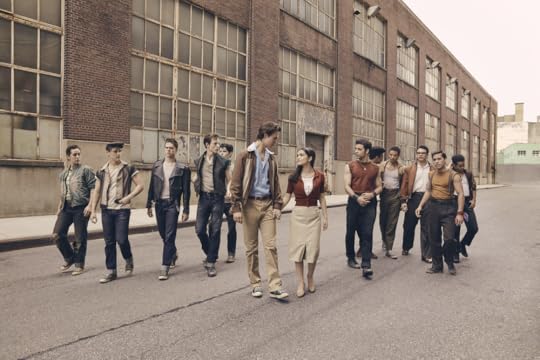
In exploring the question, it's useful to define the landscape a little. It turns out that defining a 'remake' can get a little tricky. This is because a remake is a form of adaptation of prior material. Adaptations have been around as long as stories have been stories. "West Side Story" is itself an adaptation of Shakespeare's "Romeo and Juliet", which is an adaptation of the tragic romance of Tristan and Isolde.
Why are those 'adaptations' and not 'remakes'? To me, it seems that it's a matter of what changes and what doesn't. The core structure of the story is consistent across the versions: two people from opposing factions fall in love, and fight (and fail) to escape the fate of people who are traitors to their 'tribe' (even if they are traitors for the sake of love). But that's just a framework. Each iteration of the story dresses that framework in different materials: the opposing factions are families in Shaekspeare, race-framed gangs in "West Side Story". The characters have different names. Tristan becomes Romeo becomes Tony. The setting, the dialogue, the details and specifics all change. But this is all 'dressing' over the same narrative frame.
In the case of these adaptations, they often also cross from one format to another. "Tristan and Isolde" is a folktale, written as a book eventually. It was adapted by Shakespeare into a stage play. "West Side Story" adapted Shakespeare's tale as a stage musical in 1957 - a genre shift within the same medium - before jumping from the stage to the screen in 1961.
In movie history, adaptations are frequent. Almost all major movies these days are adapted from prior "IP" ("Intellectual property"). Superhero comics, books, plays, magazine articles, etc. are all fodder for Hollywood stories. It's arguable that all stories are, at their core, a version of one or several proto-narratives. It's possible (and I find this to be true) that there is no purely 'original' story. For this reason, an argument against adaptation in Hollywood is an argument against storytelling itself.
But remakes are something more specific than just adaptation. Typically, in a remake, the character names are the same. The setting is the same. In some cases, even lines of dialogue are the same.
In theater, this actually happens all the time. Every time a theater mounts a production of "Romeo and Juliet", they're essentially remaking Shakespeare's original. They're using the same script, but the specifics of the performance change. No one seems to object to this practice in theater because it's essential. A play that is not performed is effectively dead.
Movies are different because they are a recorded medium. Although the original "West Side Story" was released in the early 1960s, I can still see it (in fact, I have the VHS in my collection, and my VCR still works...) There is no need to re-tell the story: as long as the recording is available, the movie remains alive.
For this reason, remakes often beg the question: "why bother?" Fans of an original film often find the very idea of a remake objectionable. Why try to recapture magic that's already been captured? Why make a new movie when you can still enjoy the old one?
The answer can be found back in the theater. Productions that 'remake' Shakespeare plays rarely make an effort to match the details of Shakespeare's original productions. One of my favorite theater experiences was a high school production of "Macbeth", directed by Jason Slavick at Gann Academy in Waltham, Massachusetts in the early 2000s. The production borrowed a "Mad Max" post-Apocalyptic deisel-punk aesthetic and staged the play in the round, with the audience completely surrounding the stage. It was brutal, intense, raw... and completely unlike anything Shakespeare could have imagined. (And let's not forget what might be the most shocking departure from the Shakespearian original: women in the play were played by actual women!)
To me, this is indicative of an important feature of a successful remake: it brings something into the story that was not around, or could not have been done, or was not acceptable when the story was previously told.
Diesel-punk Shakespeare is a bold move. Movie remakes don't need to be so bold, as long as they incorporate something new into the story.
In movie remakes, new elements can be technological (use IMAX cameras or color film), aesthetic (use modern acting methods) or narrative (incorporate technology into the story that didn't exist when the original was made, or work with people who wouldn't have had access to the original production).
"West Side Story" benefits from many innovations on the original, but most of the innovations are subtle. The cinematography and color work is more sophisticated, utilizing technologies that afford a greater degree of flexibility than the original filmmakers could have dreamed of. The performances are more naturalistic, suiting our current "method"-inspired tastes better than the more heavily stage-influenced performances of the original. Perhaps most significantly, the remake strives for (and largely achieves) an authenticity that's missing from the original in the casting of Latino actors in Latino roles, and in permitting Spanish to weave in and out of certain key scenes - choices that could not have been made for cultural reasons in the early '60s.
A brief aside about the use of Spanish without subtitles: The Jawas in "Star Wars" are rarely subtitled, and I don't hear any complaints.
But innovation alone isn't enough of a reason to justify a remake of a classic film (in my humblest opinion). So there are new cameras? So what?
Ultimately, the innovations that are woven into a remake need to somehow elevate the story. To make it better. This is why fans often object to remakes of films that they love. "How could it possibly be better?"
I've only seen the new "West Side Story" once, so it's hard to recall precise details, but I think Spielberg found innovations that did improve on the original. The use of Spanish and the Latino casting didn't just give the film a new degree of authenticity, but - to me, at least - it helped make the story clearer. I remember being confused by the original. Who's who? Why are they at each other's throats? I couldn't tell the difference between the Sharks and the Jets.
Another interesting consequence is that the authentic portrayal of the Puerto Rican characters opens the door for a more honest look at the white kids - a portrayal that would ring false and hypocritical if it were one-sided. And this, in turn, contributes to an overall re-balancing of the story. The Sharks and the Jets are - ultimately - both victims as well as perpetrators, sucking each other deeper into cycles of brutality and hatred.
In the original film, I never really responded to "There's a Place for Us". It's a lovely song, but I didn't really get it. Spielberg's version made me sob. By making changes that could only be allowed by today's sociopolitical climate (as opposed to that of the '60s), Spielberg was better able to paint a world where hatred begets hatred, and where "There's a Place for Us" becomes a true prayer - a wish uttered by lovers and dreamers for a world where "we'll find a way of forgiving".
So when I'm asked "what are your thoughts about remakes?" I say it depends. Does the remake introduce something new to the story that couldn't have been part of it before? Does the innovation somehow change or elevate the way the story comes across? In other words, does the remake justify itself? To my mind, "West Side Story" certainly does.
December 2, 2021
Book Trailer Launch!
The book trailer is ready! And I just posted it to the Pirate Captain Toledano Facebook page.
https://www.youtube.com/watch?v=1aN_0tK27ME“José and the Pirate Captain Toledano” will hit bookstores on 5/1/22, but it is already available for pre-orders on Amazon and other popular online retailers. You can pre-order your copy here: ,https://amzn.to/3G5dLWE
I’m really excited about this middle-grade graphic novel, and I’m even more excited to share it with the world. The book isn’t just a swashbuckling adventure (though there’s plenty of that!) it’s also a book about overcoming hatred, celebrating difference and fighting for what’s right. I think the world could use a good story like this. The trouble is, I can only make little waves on my own. I need lots of help to make a big splash.So if you'd like to help me spread the word, here are somethings you can do:-Share the trailer! Not just on Facebook, but on all your favorite social media platforms - and don’t forget those WhatsApp groups, and the email list you’re part of… Here’s the YouTube link:-Invite people to ‘like’ our Facebook page! You can tag @jewishpirates-Encourage your friends to pre-order, too! The book is available for pre-orders online at Amazon, Barnes and Noble, Target, Walmart, etc.If you know book reviewers, bloggers, or important taste-makers who might find the book compelling, make sure they know about it, too. If they’d like a review copy, I can make that happen, or they can contact the publisher directly at www.karben.com.
I’ve always cherished the support of “Team Toledano” - from the overwhelming response to the crowdfunding campaign that launched the short film, to the wonderful way they all embraced the film, to the patient anticipation they've all shown for the book. I think "Team Toledano" is going to grow quite a bit this year. I can't wait to share the book with everyone!
-Arnon
October 5, 2021
Visiting The Real Cotopaxi
This summer, I had the opportunity to visit the setting of one of my recent screenplays. It's a special hidden corner of the American West: An old cemetery that is the last remnant of the failed Jewish settlement in Cotopaxi, Colorado.
For years, I had been looking for a story to tell that blends Jewish history and the American West. I love Westerns, but except for a couple of ironic comedies, they never include any Jewish characters or narratives. History relates a different story, where Jews figured (sometimes prominently) into the fabric of America's 19th century frontier.
What's in a Name?As I researched, the Cotopaxi story caught my eye. I'll be honest, the real reason it captured my attention had nothing to do with the story itself, but with the name of the place. "Cotopaxi" is the name of the huge ship that mysteriously appears in the middle of the desert at the start of Steven Spielberg's "Close Encounters of the Third Kind"! I've always loved that moment in the film. Another screenplay of mine, "Man out of Time", is set in a fictional subterranean science facility called "Cotopaxi Laboratories".
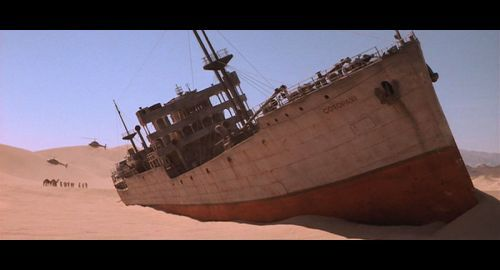
There was a real ship named Cotopaxi, shipwrecked in the Bermuda Triangle in the 1920s (and only recently found).
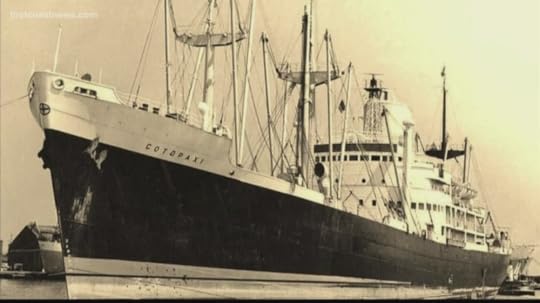
And all of these, along with the town in Colorado, were presumably named for Cotopaxi mountain in Ecuador.

The story of the Cotopaxi Jews is a tiny blip in American history. If a small town in the Rockies hadn't been named for a particular mountain in Ecuador, I might have missed the story altogether!
The Cotopaxi ColonyIn the early 1880s, a group of Jews fled a small Russian town in search of a better life in America. They first came to New York, where Jewish resettlement charities connected them with a wealthy Jewish merchant named Saltiel who owned lots of land in the Colorado mountains.
Saltiel offered to resettle the Jews on his land. He promised housing, farmland, and all the opportunity of the American West. So the Jews boarded trains and made their way across the country to a small town with an unusual name on the banks of the Arkansas River.
By many accounts, Saltiel was not an honest broker. When the Russian Jews arrived, only a fraction of their houses were built, their land was so rocky that no crops would grow... and winter was coming. Saltiel, who had contracts with local railroad companies, offered the Jews low-wage jobs hauling lumber or working in his mine. He also owned the town's general store, so whatever meager wages the Jews earned would end up back in his pocket eventually. The way it looks to me, Saltiel just wanted cheap labor, and found a way to get it.
But the Cotopaxi Jews gave it their all. They planted fifteen bags of potatoes (and - frustratingly - reaped only fourteen). They procured a Torah and established a small synagogue. And they asked Saltiel for more help.
Saltiel ignored their requests, eventually leaving Colorado for other territories. He met his end in Wyoming, and was buried in an unmarked grave.
The Cotopaxi Jews endured three harsh winters in the Rockies before disbanding the settlement. Most re-settled in other parts of the American West, and many helped grow the roots of prominent Western Jewish communities.
The Golem of CotopaxiI found the story of the Cotopaxi Jews captivating. But insufficient. It makes for gripping history, but isn't the kind of story I enjoy writing. I wanted to find a way to use it as a backbone for something fictional, something fantastical - a way to weave history into legend, in the way that all great Westerns do.
You see, for the most part, the real American West looked nothing like the "Wild West" of movies. The Western is a Great American Legend, not a history. So if I wanted to bring Jews into that Legend, I felt like I had to do it through fantasy rather than fact.
So I came up with a Golem story and grounded it in the mountain country between the Monarch Pass and the Arkansas River, right around the collapse of the Cotopaxi colony. I researched the region and its people, from the Ute Indians to the Denver and Rio Grande Railroad. It got to the point where I could really picture the stagecoach roads and the paths through the hills.
But I had never been there.
The Real CotopaxiThis past summer, my family embarked on an ambitious cross-country road trip. When we planned our itinerary, I nudged the route carefully towards the Monarch Pass. We would drive right past Cotopaxi on our way across the Continental Divide.
We visited several points that feature prominently in my screenplay. The Pass itself, the town of Salida (where we met my screenwriting friend, ), and Cotopaxi.
We drove along the Arkansas River towards Cotopaxi, and I could see the railroad tracks - the same tracks my characters ride along in my screenplay. Near the tracks, barely visible, the hints of an old stagecoach road. I had seen it many times in my head - seen it or imagined it. But here it was.
I knew that up ahead there would be a turn across a bridge, and we'd be in Cotopaxi. To the right, the old train station (or, where the building once stood). Beyond it, a modern public school, and behind the school building, tucked into an overgrown hillside, the cemetery.
That cemetery was our destination. It's pretty much the only thing left from the Jewish colony. It had been mostly forgotten, too, until some preservationists restored it a few years ago.
Eventually, I found the path that led to the cemetery. My wife and kids stayed in the RV, and I took my camera, popped upon the umbrella and made the short trek to the cemetery gate.
I was nervous, and forgot to adjust my camera settings. The first photos are blurry.
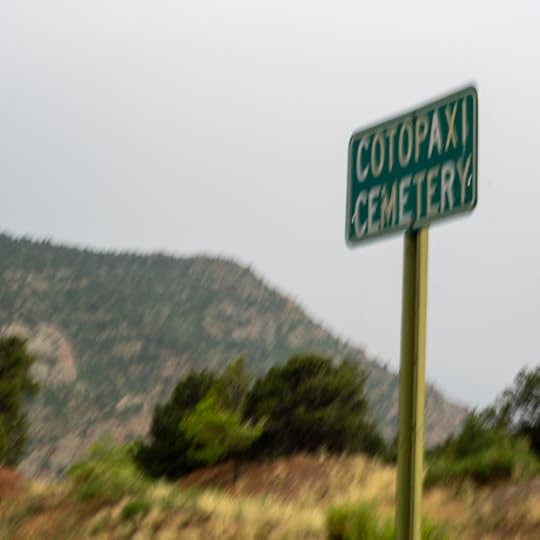
Up there, in the plateau beyond the Cemetery sign, that's where the colony once stood.
The Cemetery in Cotopaxi was established in 1882 - by the Jews, when a child passed away. A Christian cemetery soon grew around the Jewish plots.
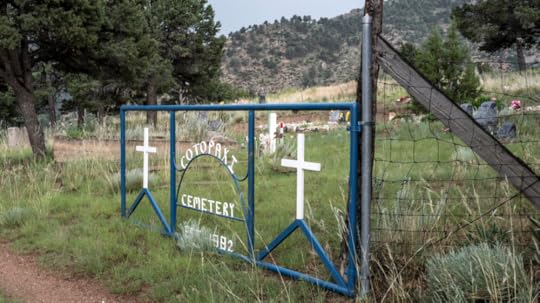
But there they are, marked by newly-added signage and symbols.
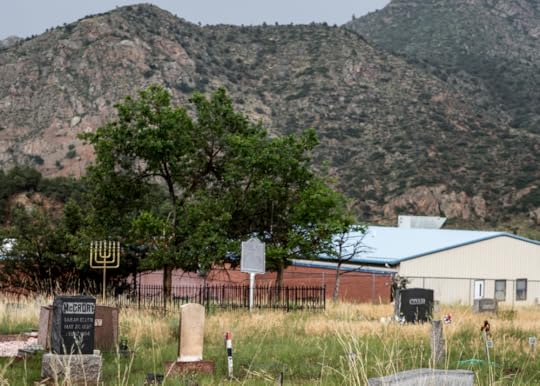
The brief explanation, with the Cotopaxi Colony's location up in the hills beyond.
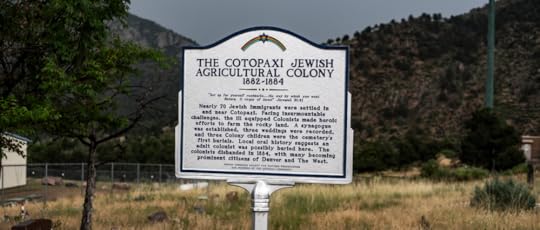
The original grave marker - added sometime after the Colony's collapse.
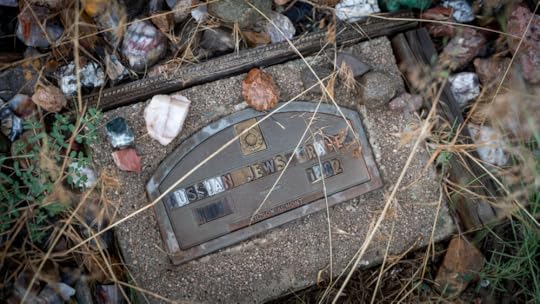
A new marker, a little more specific, added a century later.
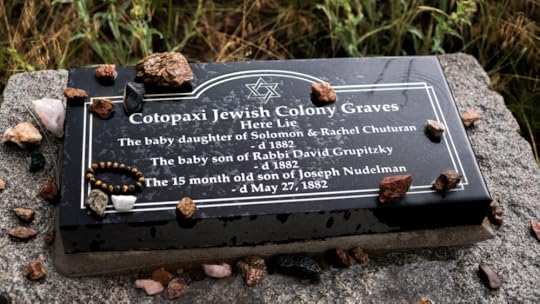
A mythical version of Rabbi David Grupitzky features heavily in my screenplay. And here, the real Rabbi Grupitzky buried his son.
Visiting the real Cotopaxi was a deeply moving experience for me. Seeing the graves of the Cotopaxi Jews... I felt a sudden burden of responsibility. I know my story isn't their story - it's made up. But I hope that I honor them through it, somehow. I hope I can use my fiction to shed some light on their historical fact, and to bring some of their legacy into the Great American Story.
Read more about "The Golem of Cotopaxi":
To read the screenplay on Coverfly, click here.
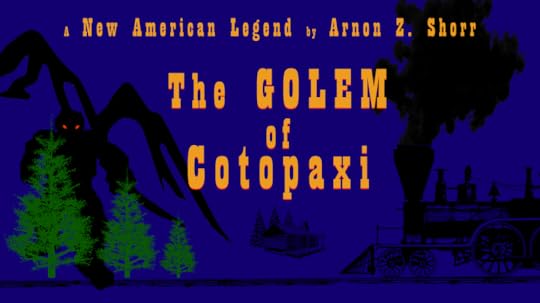
June 29, 2021
"The Wages of Fear", Spielberg's "Duel" and William Goldman: An Appreciation of Simplicity
At last, after hearing about it for years, I finally saw "THE WAGES OF FEAR" (1953, Clouzot) (I caught it streaming on HBOMax, but it's also available from The Criterion Collection.)
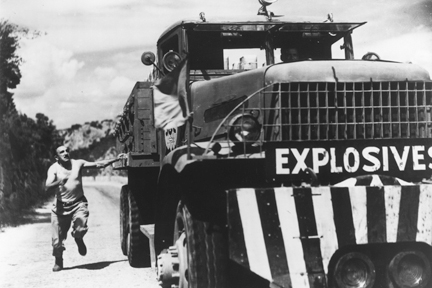
The film is a tense (if lengthy) thriller with an exceptionally simple premise: Four men have to transport two trucks full of a volatile material that explodes if jostled - through hundreds of miles of bumpy terrain.
It was re-made in English in 1977 by William Friedkin, with the also-opaque title, "SORCERER", and was a heavy inspiration for a recent episode of 'THE MANDALORIAN", but most interesting to me is its clear influence on an earlier film (one of my favorites), Spielberg's "DUEL" (1971).
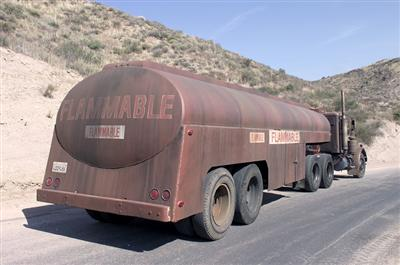
What struck me about "The Wages of Fear" was the simplicity - a simplicity that Spielberg would double-down on with his truck thriller. We learn very little about our characters beyond their poverty (their NEED - money) and their task (their GOAL). The hero, Mario (Yves Montand) reminisces about Paris a bit, M. Jo seems like a con-man, Luigi has health issues and Bimba briefly references being imprisoned in Nazi salt mines... but we hear these snippets in passing - no one reminisces about a childhood, or obsesses over an old trauma. We get very little backstory. All we know is that they're here, they're poor, desperate, and have dreams that drive them towards the money they hope to earn by this very dangerous mission.
As I watched, I was reminded of something William Goldman wrote in "Which Lie Did I Tell?" his fantastic follow-up to "Adventures in the Screen Trade". He talks about writing a character - a mysterious hunter - in one of his films, and having a movie star/producer demand that the character have a 'backstory'.
Goldman explains that once the mysterious hunter had a backstory, the mystery was lost, and the movie suffered for it. He goes on to praise mystery, and to push back against the Hollywood tendency (particularly from movie stars) to insist on explaining the "reasons" for a character's actions on screen. In fact, Goldman points out, most of our favorite movie heroes are favorites precisely because of the sense of mystery that surrounds them. We never learn about Rick's childhood in "CASABLANCA". James Bond, as far as we know, has been a double-O agent from the womb.
Spielberg, who in 1970 was clearly influenced by Clouzot's thriller, doesn't just borrow the big truck with the boldfaced warning stenciled on its back. He borrows the simplicity, too. in "DUEL", David Mann also comes with pretty much no backstory. We don't learn anything about how he got to be the way he is. We know what's driving him now - his shoddy marriage, his scrabbling in a lousy job just to survive. But we learn nothing about what made him the way he is - because we don't need it. Spielberg provides us with the basic information we need to understand what's happening in this film. And that's it. Narrative immediacy.
Here's why this works: When we get a lot of information about a character's background, that character becomes a little too real. Too much of a separate person. We find ourselves watching that character, not being that character. But movies aren't merely observational. They afford us an opportunity to get out of our own heads and into the experience of a fictional other. When there are gaps in the character, big areas of the character's backstory that aren't revealed to us, it creates room for us to put ourselves there instead. We're tense when Mario drives over a bumpy road because - in a way - we are Mario. If we knew more about him, we'd have a harder time putting ourselves in his place, sharing his identity during the movie-watching experience.
Spielberg, in particular, goes to great lengths to align his audience with his characters (See my video on his "Point of Thought" technique - it's the visual way he achieves character/audience alignment.) It is, perhaps, one of the reasons his films tend to be so popular. Simplicity - a calculated withholding of backstory - is another of Spielberg's tools.
[I should note: another point Goldman makes often in his book is that directors often get credit for screenwriters' decisions. Yes, it's the writer who chooses whether to include or omit backstory... but it's the director who chooses the script (assuming the director has some clout). So, on this point, I disagree somewhat with Goldman. The director still gets at least some of the credit (or the blame!)]
If you're a savvy Spielberg fan, you might protest my assertions here. You might point out that some of the great scenes in Spielberg's early films are all about backstory. In "JAWS" (1975) Quint's haunting recollection of the sinking Indianapolis may be one of the greatest expositions of backstory ever committed to film!
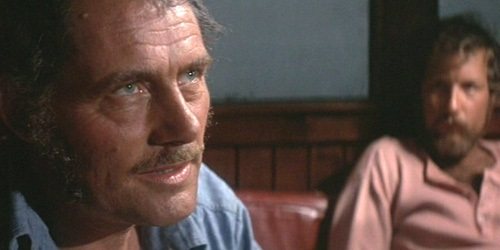
Even in "THE WAGES OF FEAR", the characters share bits and pieces of their past. It's valuable to consider which bits and pieces are shared. They're all memories or experiences that directly inform the current story. They don't tell us how they got here. Instead, they tell us what they're thinking/feeling now.
In "JAWS", we don't need to know why Quint became a fisherman. But we need to know why he insists on pursuing this great white shark when he could cut his losses and go home. In "DUEL", we need to know why David Mann doesn't turn around and go home: there's not much of a home life for him to return to. In "THE WAGES OF FEAR" we need to know why the four drivers keep going - what's driving them? We need to know their desperation, and what they hope to achieve, but we don't need to know how they got into their desperate position.
Here's the valuable lesson for screenwriters and filmmakers: if you're considering whether to include a detail about a character, consider its narrative immediacy. If it's a detail that helps us understand why a character takes an action now, it may be important to include. But if it's just there to help us understand how a character got to this point in the story - if it's pure 'backstory' without immediate relevance, it may be best to leave out entirely. Give your audience room to enter your characters, to become them. Don't crowd your audience out!
May 19, 2021
Writing While I Wait...
Although I've spent a long time in the moviemaking world, "José and the Pirate Captain Toledano" is my first book. Movies take a long time to pull together... and as it turns out, books do, too! Especially a graphic novel such as this one.
Artist Joshua Edelglass has been working tirelessly on the art for many months, penciling, inking and painting entirely on his own. He's almost done with the whole book, which got me to reflect on the journey so far.
Josh and I landed our book deal with Kar-Ben Publishing early in 2020, just as the COVID pandemic was about to crash down upon us. As the book's author, I faced the first hurdle - to write the book!
With the kids locked down at home (including the baby, who was only a few months old) and with my wife still working (doctors are considered essential workers during a global health crisis), I had very little time to actually write. I got most of it done during very early mornings (before the kids woke up). On days when my wife was home and could take over the childcare, I did marathon writing sessions in our bedroom closet - the only place the noise of the house wouldn't penetrate.
By early April, I had completed the first draft of the book.
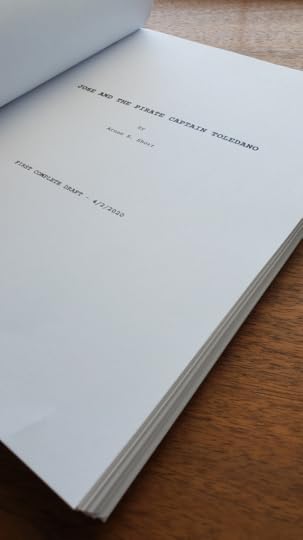
I remember printing it out - a thicker document than any I had ever produced - and feeling its very real weight in my hands. After getting Josh's notes, I submitted the draft to the publisher, anxious about what feedback they might have.
It was a very long time (or, it seemed like a very long time) before we got a response. I got more anxious. Did they hate it? Are they marking it up? Are they going to send it back with pages and pages of red ink?
My book agent, Anna Olswanger, reminded me that I'm not in Kansas anymore - the book world doesn't operate at the Hollywood pace I'm used to. Things take their time.
So, I waited, and eventually, the notes came. And there were... pretty much none! They loved it!
And that's it for me. I had very little more to do from that point on. Josh, on the other hand... his hands got very, very full.
Penciling - which includes laying out how the images flow on the page - was the first big step. Josh worked for weeks, sending me pages as he went. I'd give him notes here and there, but most of the experience, for me, involved the joy of seeing my words come to life as images for the first time.
When the penciling was done, Josh submitted the pages to the publisher for their notes. Once again, we waited... and when the notes came back, they were (again!) very sparse. We're so lucky!
Josh then inked all the pages - again, sending me the works in progress as he went. Once the inking was done, we discussed colors, and Josh dove into the painting process.
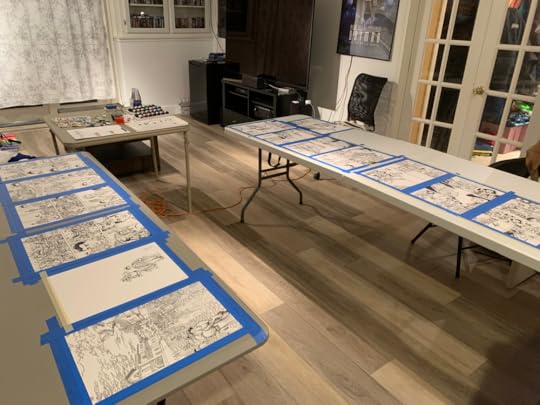
Every page of this book, you must understand, is painted by hand. I don't know how Josh's fingers haven't fallen off by now! It's a painstaking, laborious process... and it's done! Josh finished painting just yesterday!
There's still one more step to complete: To finish the pages, Josh scans the artwork into a computer, and uses software to layer the deep black lines from his inked pages on top of the paint. It's a method of creating vivid painted pages without losing the crispness of the ink. Fortunately, Josh has been doing much of this work as he goes, so it won't take much longer before everything is submitted to Kar-Ben for the lettering/typesetting and final layout.
For those of you who've been keeping score, it's been roughly a year and a quarter since I started writing the book! More than a year since I submitted the draft to the publisher! What have I been doing all this time?
Looking back at what felt like a very long year of lockdown, isolation, parenting responsibilities in overdrive... I'm surprised at what I've accomplished. I wrote two original screenplays ("The Golem of Cotopaxi" and "Out of the Sky"), plus two more with a writing partner. I got hired to write an adapted screenplay (first draft's done, working on revisions now) and shortly after that, got hired to re-write another screenplay along with its original writer. Almost done with that draft, too. That's six feature screenplays! Yikes! I overhauled my social media, rebuilt my website, and began the preparations for a big move back to the east coast (I posted about this on Facebook, and will likely explore it further here at some point). It's been a productive year!
Although I'm terribly impatient about it, there's something nice about the slow pace of the publishing world. While the book is on its way, I get to spend time gestating new ideas, creating new content, and generally coming up with lots of answers to "what's next?" I've never had that luxury as a filmmaker (especially as an indie filmmaker, where I wear multiple hats). On my films, I've typically worked right up through the festival run, and only once that petered out did I have time to come up for air and wonder what the next project would be. Maybe Hollywood could take a note from the publishing world? Slowness might be a good thing!
And even now, with the art nearly finished, we're still quite a long way out from the book's publication date. Put March 1, 2022 in your calendars - that's when "José and the Pirate Captain Toledano" is due to hit bookstores. Until then, I'll keep writing. We'll see how many more screenplays I churn out (or maybe I'll write another book? Or maybe I'll find my way back into the director's chair?) Whatever I come up with, I'll keep you posted here!



